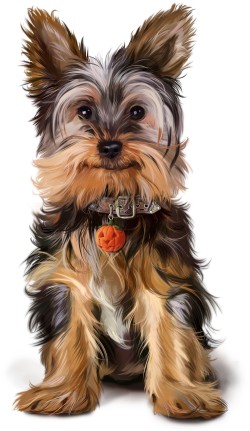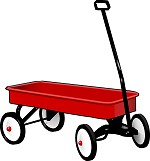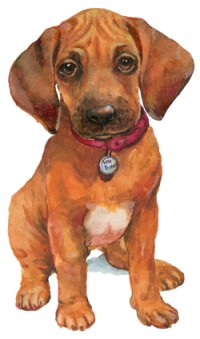Do these 3 things and your pup's behavior will be (nearly) perfect
By Michele Welton, Dog Trainer, Breed Selection Consultant, Author of 15 Dog Books
 Now, no one (human or canine) is perfect! But your pup's behavior will be nearly perfect if you do just 3 things.
Now, no one (human or canine) is perfect! But your pup's behavior will be nearly perfect if you do just 3 things.
1) Provide a structured life filled with routines.
2) Provide positive and negative consequences.
3) Act like a calm, confident leader.
First, provide a structured life filled with routines.
Dogs thrive on sameness, routines that are familiar, predictable, repeated. As much as possible, do the same things with your dog every day – the same things in the same order, using the same words.
Also show your pup what you expect him to do as his part of the routine. Once he learns the routine for, say, meal time, if you do your part, he will do his part. Automatically. Day in and day out.
The trick is to make sure the routines your puppy is learning are good ones that lead to good behavior. If he learns bad routines, he will repeat them just as readily! The vast majority of behavior problems in dogs are caused by the owner (inadvertently) teaching the pup bad routines, or allowing the pup to create his own bad routines.
You want to create good routines that cover bedtime, wake-up time, meal time, play time, walk time, grooming time, potty breaks, and so on. Dogs feel most secure when their life is structured and predictable.
Second, provide positive and negative consequences.
Dogs are opportunists, which means they're always on the lookout for opportunities to get something good for themselves.
If you add a reward (a positive consequence) to a behavior you want your puppy to do (greeting guests politely, standing still while you brush him, going to the bathroom in the right place), he's more likely to repeat that behavior.
On the flip side, dogs try to avoid doing things that make them feel uncomfortable or unhappy. If you attach a negative consequence to a behavior you don't want him to do (jumping on people, barking, chasing the cat), he'll avoid repeating that behavior.
Your puppy needs both thumbs-up and thumbs-down feedback so he will make good choices.
We call this Balanced training, where you reward the good and correct the bad. Sometimes it's called Yes & No training because you tell your pup Yes for some behaviors, and No for others. It's the perfect training method for canines, matching the commonsense way they learn.
But isn't it "mean" to correct a dog?
Absolutely not. Corrections give your puppy valuable information about the behaviors that you don't want him to do. How else is he to know?
There is a dog training philosophy called positive reinforcement ONLY (or purely positive). It starts with the exact same positive reinforcement that I use – praise, food, petting, toys, and gentle guidance with your hands or the leash.
 So far, so good! But there's a reason it's called positive ONLY and this is where the wheels come off the wagon.
So far, so good! But there's a reason it's called positive ONLY and this is where the wheels come off the wagon.
With positive ONLY training, no matter how bad a dog's behavior is (lunging at other dogs, stealing food off your table, knocking people over by jumping), you don't correct it with anything that might make the dog feel uncomfortable or "sad" – not even for a moment, and not even if doing so would completely eradicate the bad behavior so that it never came up again.
Some positive ONLY trainers won't even say "No."
Imagine if we raised our kids that way.
No, if you want your pup to STOP doing something – stop pulling on the leash, stop jumping on people, stop lunging toward other dogs, stop barking, stop stealing food, stop chasing the cat....
....positive ONLY doesn't work.
Think about it. What happens when you want your pup to stop chasing a cat and come to you, but at that particular moment he's not hungry and would rather chase the cat than munch on a biscuit?
Owners who rely on positive ONLY training are stuck whenever their puppy "isn't in the mood" to do something, or even more importantly, to STOP doing something.

An old trainer once remarked that if a dog really wants to chase a cat, he will chase it "regardless of biscuits showering upon him like manna from heaven."
So if you've watched a YouTube video that claims you can teach your dog to (reliably and always) stop jumping on people simply by teaching him to sit, they're quite wrong.
If a pup likes to jump on people, and you simply teach him how to sit for a treat – without correcting the jumping – he learns that sitting brings him a treat, sure. But he also doesn't forget how much he enjoys jumping! So at any given time, you can never know whether he will choose the treat or the fun of jumping.
If both behaviors bring him a reward, how is he supposed to choose? Flip a coin? His behavior ends up depending on which reward he wants most at that moment.
In fact, when you think about it, if your puppy jumps on someone and you pull him off and coax him to sit and then give him a treat, you're rewarding him for jumping. Remember how quickly puppies learn patterns: "First I jump. Then I sit and get a treat. Therefore, to get a treat, I must start by jumping!" Ugh.
No, if you want your puppy to not jump, don't add positive consequences anywhere close to the jumping behavior, else you'll get more jumping. If you want less jumping, you need to add a negative consequence. Once he demonstrates (consistently!) that he has decided to "not jump" any more, then bring forth the treats and teach him to sit.
Balanced training (positive and negative consequences) makes logical sense to your puppy. He wants to know – needs to know – what happens if he does A and what happens if he does B. Then he can make informed choices.
Third, act like a calm, confident leader.
 Show your puppy that you're in control of everything in his life, that everything good comes from you, and that he should look to you for guidance and direction. Then he will be happy to be a respectful follower.
Show your puppy that you're in control of everything in his life, that everything good comes from you, and that he should look to you for guidance and direction. Then he will be happy to be a respectful follower.
Dogs are born with an instinctive desire to belong to a social group (a family or pack).
When a puppy joins your family, even if your family is only the two of you, his instincts compel him to seek out its structure:
- Who is the leader who sets the boundaries?
- Who are the followers who follow the leader?
Dogs don't want to be leaders.
The vast majority of pups don't want to be leaders. They really, really don't want to be leaders. They feel much more secure and happier as followers.
But a dog isn't comfortable in a world where no one seems to be in charge.
So if you're not comfortable providing guidance and direction and setting firm boundaries, if you feel guilty about saying "No" to your pup and making it stick.... well, that's not going to sit well with your pup and he will probably try to assume the leadership role himself.
That doesn't mean he's a "dominant" dog with ambitions to rule your household with an iron paw. It doesn't mean he wants to be in charge. It just means that he knows how important it is that someone be in charge.
Since you've fallen down on the job, he's trying to fill that role for you.
If your puppy is the leader
When you fail to act like a leader and your pup is forced to pick up the slack, you'll see behavior problems when you try to get him to do something he definitely doesn't want to do.
For example, he might bark back at you when you give a command. He might struggle in your arms when you try to restrain him or clip his nails or brush his teeth. He might resist being picked up or growl when you try to take a toy away. He might not come when you call him (assuming that you've actually taught him what Come means).
Since you haven't shown him that you're the one making the decisions, he doesn't understand why he should do what you say. That's not how canines run things.
Your lack of leadership jeopardizes your pup's health and safety because there will be times in his life when you'll need to do things that he doesn't understand and doesn't enjoy:
- give him medicine that tastes awful
- remove something from his mouth
- roll him over to pluck a disgusting tick off his belly
Your puppy can't understand that medicines will help him, that things he picks up from the ground might poison him or choke him, that ticks carry disease and must be removed. Without this knowledge, your pup doesn't know what's best for him.
For his own safety, he has to accept your greater knowledge and judgment in every aspect of his life. But he will only do that if he trusts your leadership.
Does your puppy view you as his trusted leader?
- When visitors come to the door, does your pup bark a warning, but then look at you, expecting you to take over and handle the situation? That's trusting you as the leader. Or does he rush the door and pitch an ongoing fit, making his own decision about how to deal with this visitor?
- When you're ready to go for a walk and you open the door or gate, does your pup wait for your permission to go through? That's showing polite respect for you as the leader. Or does he lunge through the door or gate the moment it opens, oblivious to your presence at the other end of the leash?
- Does your pup walk nicely on a loose leash, glancing at you regularly to see which direction you want to go in? That's recognizing you as the leader. Or does he pull you around and make his own decisions to go left or right, fast or slow?
- When a stranger or a strange dog approaches, does your pup look at you, expecting you to handle the situation? That's trusting you as the leader. Or does he make his own decision to bark and pull and lunge at other people or other dogs?
You are your puppy's caregiver. Your relationship with him should be one where he is taught to look trustingly at you for guidance and direction. That's the relationship that every dog thrives on.
Make yourself important – the most important thing – in your puppy's life. Encourage him to look at you and come toward you; reward him with pleased praise. Be the decision-maker when it comes to his toys, games, meal time, bedtime... even which way to go for a walk. You decide. Show him the black-and-white rules and routines he is to follow, then make sure he does, and praise/reward.
How to establish yourself as the leader
- Establish good patterns and routines that govern everything your pup does.
- Teach him to be calm and to look to you for guidance, direction, and permission.
- Make yourself important – the most important thing – in your puppy's life. Encourage him to look at you and come toward you. Step up and be the decision-maker. Show him the clear, black-and-white rules and routines he is to follow, and then make sure he does.
Those simple actions are viewed by your puppy as the actions of a leader. If you follow my articles faithfully, the result will be a calm, well-behaved pup who loves, trusts, AND respects you.


 Respect Training For Puppies: 30 seconds to a calm, polite, well-behaved puppy
Respect Training For Puppies: 30 seconds to a calm, polite, well-behaved puppy Teach Your Dog 100 English Words
Teach Your Dog 100 English Words 11 Things You Must Do Right To Keep Your Dog Healthy and Happy
11 Things You Must Do Right To Keep Your Dog Healthy and Happy